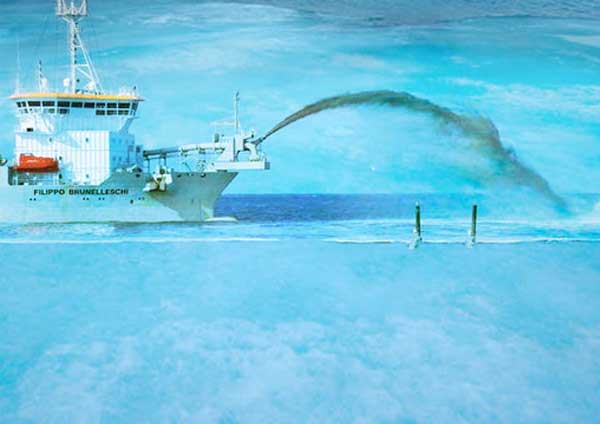Dredging
Dredging
Underwater excavation is called dredging. Dredging is the process by which a water body is deepened. In simple terms, dredging means removal of material from the bottom of a water body. Removal of sediment or other material from an aquatic area for the purpose of deepening the area, obtaining fill material, or maintaining existing structure is known as dredging. Dredging takes place to maintain the depth in existing ports, harbors and channels to provide ready and safe passage for commercial and recreational vessels. Dredging is done to create new or deeper access or berths for vessels. This means deepening and widening of channels and anchorages as well as the excavation of basins and marinas from areas of previously dry land.

Types of dredging vessel:
Suction :
Suction dredges are essentially underwater vacuum cleaners. They are commonly used to pull material up from a stream bottom, run through a separation system to recover valuable minerals, and then redeposit the stream material back onto the bottom of the stream. Suction dredging is mostly done in a very dynamic environment, a natural stream or river.
Trailer suction :
A trailing suction hopper dredger is a large ocean going vessel. When the vessel starts dredging, the ship reduces its speed to some 1 to 2 knots and then lowers the suction pipes on both sides of the ship all the way to the seabed. Sand pumps transfer the sand dredged up by the suction head into the hold or hopper. The excess water is drained of via the overflow pipes. When the hopper is full, the ship sails to its destination, the reclamation area.
Cutter suction :
Cutter suction has to be towed to their work site by tugboats. Cutter suction dredgers are suitable to dredge hard soil or to pump o\up large amounts of sand in shallow water.
Auger suction :
Augur suction operates in the same manner as the cutter suction, except that the mechanical cutting tool is a rotating Archimedean screw placed at right angles to the suction pipe.
Pneumatic dredge :
Pneumatic dredgers work on the evacutor principle. A chamber with inlets for bed material is pumped out with the inlets closed. The inlets are then opened and water and material drawn in. The mixture is then pumped out and the cycle repeated. The unit is generally suspended from a crane on land or from a small pontoon or barge. The dredging action is intermittent and suitable only for easily flowing material.
Air lift dredger :
Air lift dredgers are very similar to the jet-lift dredgers but the medium for inducing water and material flow is high pressure air injected at the month of the suction pipe. As with jet-lift dredgers there are no moving parts in the flow system. Hard or other difficult to loosen materials cannot be dredged.
Amphibious dredgers :
Amphibious dredgers have the unusual feature of being able to work afloat or elevated clear of the water surface on legs. They can be equipped with grabs, buckets or a shovel installation.
Some of the major dredging companies are Royal Boskalis Westminister, Jan De Nul, DEME and Van Oord Dredging and Marine Contractors.








